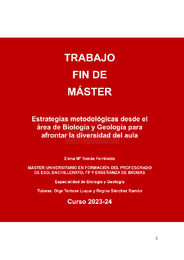Please use this identifier to cite or link to this item:
https://hdl.handle.net/11000/32881Full metadata record
| DC Field | Value | Language |
|---|---|---|
| dc.contributor.advisor | Tortosa Luque, Olga | - |
| dc.contributor.advisor | Sánchez Ramón, Regina | - |
| dc.contributor.author | Tomás Ferrández, Elena María | - |
| dc.contributor.other | Departamentos de la UMH::Estadística, Matemáticas e Informática | es_ES |
| dc.date.accessioned | 2024-08-02T10:11:23Z | - |
| dc.date.available | 2024-08-02T10:11:23Z | - |
| dc.date.created | 2024-06 | - |
| dc.identifier.uri | https://hdl.handle.net/11000/32881 | - |
| dc.description | Especialidad: Biología y Geología | es_ES |
| dc.description.abstract | La mente humana ha sido una incógnita que siempre se ha querido resolver y gracias a los numerosos estudios de los últimos 30 años cada vez se conocen más y más de sus estructuras, funciones, enfermedades y cambios en general. Como con todo lo antes desconocido, el ser humano se ha implicado en su estudio de manera incesante y gracias a eso hoy se pueden comprender hechos tan insólitos como la creación de la memoria, los pensamientos o cómo se genera el propio aprendizaje. Sobre este último es sobre lo que versa este Trabajo de fin de Máster. En él, se plantean las nociones básicas de aprendizaje y de memoria y cómo se relacionan con la educación, dando paso a términos como la Neuroeducación y Neurodidáctica para poder comprender las barreras a las que se enfrenta el estudiantado y los docentes y establecer las estrategias metodológicas para hacerles frente y así favorecer el aprendizaje atendiendo a los diferentes ritmos de aprendizaje, incluyendo a la diversidad del estudiantado y atendiendo a la diversidad del aula, incluyendo a estudiantado con Trastorno de Atención e Hiperactividad, Trastorno del Espectro Autista (TEA) o estudiantes con altas capacidades. | es_ES |
| dc.description.abstract | The human mind has always been a mystery that we have always wanted to solve and thanks to the numerous studies of the last 30 years we know more and more about its structures, functions, diseases and changes in general. As with everything previously unknown, the human being has been involved in its study incessantly and thanks to that today we can understand facts as unusual as the creation of memory, thoughts or how learning itself is generated. It is about the latter that this Master's thesis deals with. In it, the basic notions of learning and memory and how they relate to education are raised, giving way to terms such as Neuroeducation and Neurodidactics in order to understand the barriers faced by students and teachers and establish methodological strategies to address them and thus promote learning by addressing the different learning rhythms, including the diversity of the student body and the diversity of the classroom, including students with Attention Deficit Hyperactivity Disorder (ADHD), Autism Spectrum Disorder (ASD) or students with high abilities. | es_ES |
| dc.format | application/pdf | es_ES |
| dc.format.extent | 27 | es_ES |
| dc.language.iso | spa | es_ES |
| dc.publisher | Universidad Miguel Hernández de Elche | es_ES |
| dc.rights | info:eu-repo/semantics/openAccess | es_ES |
| dc.rights.uri | http://creativecommons.org/licenses/by-nc-nd/4.0/ | * |
| dc.subject | Neuroeducación | es_ES |
| dc.subject | Neurodidáctica | es_ES |
| dc.subject | Aprendizaje | es_ES |
| dc.subject | Neurociencia | es_ES |
| dc.subject | Autoestima | es_ES |
| dc.title | Estrategias metodológicas desde el área de Biología y Geología para afrontar la diversidad del aula | es_ES |
| dc.type | info:eu-repo/semantics/masterThesis | es_ES |

View/Open:
TOMAS FERRANDEZ, ELENA MARIA.pdf
3,48 MB
Adobe PDF
Share:
.png)
